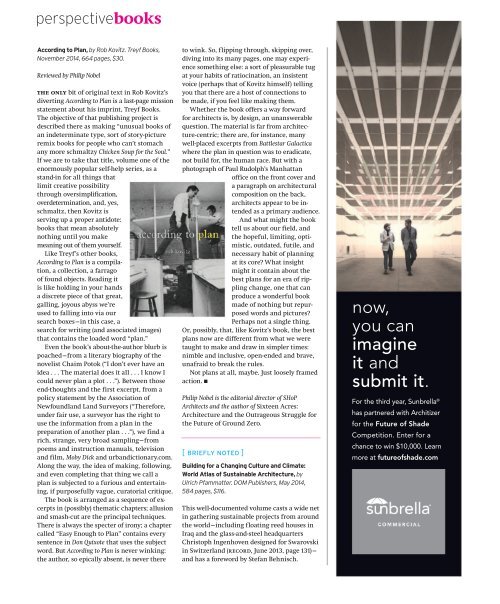Architectural Record 2015-02
You also want an ePaper? Increase the reach of your titles
YUMPU automatically turns print PDFs into web optimized ePapers that Google loves.
perspectivebooks<br />
According to Plan, by Rob Kovitz. Treyf Books,<br />
November 2014, 664 pages, $30.<br />
Reviewed by Philip Nobel<br />
the only bit of original text in Rob Kovitz’s<br />
diverting According to Plan is a last-page mission<br />
statement about his imprint, Treyf Books.<br />
The objective of that publishing project is<br />
described there as making “unusual books of<br />
an indeterminate type, sort of story-picture<br />
remix books for people who can’t stomach<br />
any more schmaltzy Chicken Soup for the Soul.”<br />
If we are to take that title, volume one of the<br />
enormously popular self-help series, as a<br />
stand-in for all things that<br />
limit creative possibility<br />
through oversimplification,<br />
overdetermination, and, yes,<br />
schmaltz, then Kovitz is<br />
serving up a proper antidote:<br />
books that mean absolutely<br />
nothing until you make<br />
meaning out of them yourself.<br />
Like Treyf’s other books,<br />
According to Plan is a compilation,<br />
a collection, a farrago<br />
of found objects. Reading it<br />
is like holding in your hands<br />
a discrete piece of that great,<br />
galling, joyous abyss we’re<br />
used to falling into via our<br />
search boxes—in this case, a<br />
search for writing (and associated images)<br />
that contains the loaded word “plan.”<br />
Even the book’s about-the-author blurb is<br />
poached—from a literary biography of the<br />
novelist Chaim Potok (“I don’t ever have an<br />
idea . . . The material does it all . . . I know I<br />
could never plan a plot . . .”). Between those<br />
end-thoughts and the first excerpt, from a<br />
policy statement by the Association of<br />
Newfoundland Land Surveyors (“Therefore,<br />
under fair use, a surveyor has the right to<br />
use the information from a plan in the<br />
preparation of another plan . . .”), we find a<br />
rich, strange, very broad sampling—from<br />
poems and instruction manuals, television<br />
and film, Moby Dick and urbandictionary.com.<br />
Along the way, the idea of making, following,<br />
and even completing that thing we call a<br />
plan is subjected to a furious and entertaining,<br />
if purposefully vague, curatorial critique.<br />
The book is arranged as a sequence of excerpts<br />
in (possibly) thematic chapters; allusion<br />
and smash-cut are the principal techniques.<br />
There is always the specter of irony; a chapter<br />
called “Easy Enough to Plan” contains every<br />
sentence in Don Quixote that uses the subject<br />
word. But According to Plan is never winking:<br />
the author, so epically absent, is never there<br />
to wink. So, flipping through, skipping over,<br />
diving into its many pages, one may experience<br />
something else: a sort of pleasurable tug<br />
at your habits of ratiocination, an insistent<br />
voice (perhaps that of Kovitz himself) telling<br />
you that there are a host of connections to<br />
be made, if you feel like making them.<br />
Whether the book offers a way forward<br />
for architects is, by design, an unanswerable<br />
question. The material is far from architecture-centric;<br />
there are, for instance, many<br />
well-placed excerpts from Battlestar Galactica<br />
where the plan in question was to eradicate,<br />
not build for, the human race. But with a<br />
photograph of Paul Rudolph’s Manhattan<br />
office on the front cover and<br />
a paragraph on architectural<br />
composition on the back,<br />
architects appear to be intended<br />
as a primary audience.<br />
And what might the book<br />
tell us about our field, and<br />
the hopeful, limiting, optimistic,<br />
outdated, futile, and<br />
necessary habit of planning<br />
at its core? What insight<br />
might it contain about the<br />
best plans for an era of rippling<br />
change, one that can<br />
produce a wonderful book<br />
made of nothing but repurposed<br />
words and pictures?<br />
Perhaps not a single thing.<br />
Or, possibly, that, like Kovitz’s book, the best<br />
plans now are different from what we were<br />
taught to make and draw in simpler times:<br />
nimble and inclusive, open-ended and brave,<br />
unafraid to break the rules.<br />
Not plans at all, maybe. Just loosely framed<br />
action. ■<br />
Philip Nobel is the editorial director of SHoP<br />
Architects and the author of Sixteen Acres:<br />
Archi tec ture and the Outrageous Struggle for<br />
the Future of Ground Zero.<br />
[ BRIEFLY NOTED ]<br />
Building for a Changing Culture and Climate:<br />
World Atlas of Sustainable Architecture, by<br />
Ulrich Pfammatter. DOM Publishers, May 2014,<br />
584 pages, $116.<br />
This well-documented volume casts a wide net<br />
in gathering sustainable projects from around<br />
the world—including floating reed houses in<br />
Iraq and the glass-and-steel headquarters<br />
Christoph Ingenhoven designed for Swarovski<br />
in Switzerland (record, June 2013, page 131)—<br />
and has a foreword by Stefan Behnisch.<br />
now,<br />
you can<br />
imagine<br />
it and<br />
submit it.<br />
For the third year, Sunbrella ®<br />
has partnered with Architizer<br />
for the Future of Shade<br />
Competition. Enter for a<br />
chance to win $10,000. Learn<br />
more at futureofshade.com


















